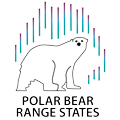- HM-A1 - Define the components necessary for a “quantitative assessment of the population”
- HM-A2 - Define “biologically sustainable harvest” in terms of conserving polar bear subpopulations for future generations
- HM-A3 - Define the components of a “demonstrated sustainable harvest management regime”
Summary of the Actions:
The harvest management actions included in the 2020-2023 action plan will jointly result in a white paper that identifies the components necessary to define a quantitative assessment of the population (HM-A1), biologically sustainable harvest (HM-A2), and a demonstrated sustainable harvest management regime (HM-A3). This suite of actions lays the groundwork for consistent assessments of harvest management regimes across the circumpolar arctic. In order to determine if harvest is sustainable in a given subpopulation, we first need to establish consistent definitions of the basic components needed to carry out an analysis. These actions provide the first step needed in this process. By ensuring that harvest is managed in a sustainable manner, we will contribute directly to the vision of the CAP (to secure the long-term persistence of polar bears in the wild that represents the genetic, behavioral, life-history, and ecological diversity of the species) by minimizing the threat of overharvest. The definitions outlined in the white paper will create a foundation for the implementation of harvest management actions in subsequent year
Action Leads:
Lindsey Mangipane (U.S. Fish and Wildlife Service,
Ruth Milkereit (Environment and Climate Change Canada,
Participants:
Representatives include individuals appointed by the Range States Heads of Delegation from the countries leading these actions (U.S. and Canada) with experience in (a) applied harvest management, (b) quantitative assessment, and (c) Circumpolar Action Plan implementation. In addition, representatives include two PBSG appointees, recommended by the PBSG co-chairs to the Range States Heads of Delegation.
- Susannah Woodruff (U.S. Fish and Wildlife Service, member)
- Erik Andersen (U.S. Fish and Wildlife Service, member)
- Lindsey Mangipane (U.S. Fish and Wildlife Service, member)
- Evan Richardson (Environment and Climate Change Canada, member)
- Sam Iverson (Environment and Climate Change Canada, member from 2020 to December 2022)
- Eric Regehr (Polar Bear Specialist Group, advisor)
- Fernando Ugarte (Polar Bear Specialist Group, advisor)
Duration of actions:
Actions HM-A1, HM-A2, and HM-A3 will run concurrently from January 2021- April 2022
Deliverables (output):
- D1. A white paper, which identifies the components necessary to define a quantitative assessment of the population (HM-A1), biologically sustainable harvest (HM-A2), and a demonstrated sustainable harvest management regime (HM-A3).
Impact (outcome):
This suite of actions lays the groundwork for consistent assessments of harvest management regimes across the circumpolar arctic. In order to determine if harvest is sustainable in a given subpopulation, we first need to establish consistent definitions of the basic components needed to carry out an analysis. These actions provide the first step needed in this process. By ensuring that harvest is managed in a sustainable manner, we will contribute directly to the vision of the CAP (to secure the long-term persistence of polar bears in the wild that represents the genetic, behavioral, life-history, and ecological diversity of the species) by minimizing the threat of overharvest.
Dissemination:
Once approved by the HoD, the white paper will be posted on the Range States website. Individual Range States will share the white paper with relevant domestic stakeholders.
